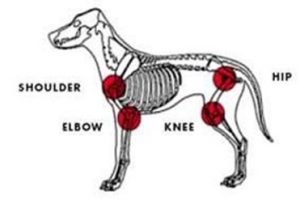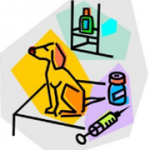What is Osteoarthritis and Why is My Dog Affected?
Osteoarthritis is a degenerative problem that affects one or more of the joints in the body. Commonly affected joints include the hips, elbows and stifles. Symptoms of osteoarthritis are joint pain and stiffness, difficulty rising/sitting and ‘slowing up’ on walks. These symptoms arise because the cartilage that normally provides cushioning and protection to the ends of the bones in joints is damaged or has worn away. Without this protection, the bones rub directly on each other causing pain.
 Age also plays an important role in the development of osteoarthritis, as the cartilage can ‘wear out’ over time. Other factors, such as the joints not fitting together properly (also known as joint dysplasia), obesity, previous joint injuries or joint surgery can accelerate the development of osteoarthritis.
Age also plays an important role in the development of osteoarthritis, as the cartilage can ‘wear out’ over time. Other factors, such as the joints not fitting together properly (also known as joint dysplasia), obesity, previous joint injuries or joint surgery can accelerate the development of osteoarthritis.
How Do I Know if My Dog Has Osteoarthritis?
If you notice the symptoms of osteoarthritis you should seek the assistance of a veterinary surgeon. There are many other conditions that affect the bones and joints that can present with symptoms similar to those of osteoarthritis. It is important to obtain an accurate diagnosis so your dog can receive the best level of care.
What Medications Can Help My Dog?
The main aim of managing osteoarthritis is to provide pain relief to ensure your dog remains comfortable. There are many different types of medication that can provide pain relief but the most commonly used drug is a non-steroidal anti-inflammatory (NSAID).
NSAIDs reduce pain and inflammation within the joint. They are prescription only medications therefore a vet needs to prescribe them for your dog. This medication comes in liquid or tablet form and are given to your dog with food. A blood test may be required if your dog takes NSAIDs for a long period of time to check the health status of his or her internal organs. This is to ensure it is safe and appropriate for NSAIDs to be used. Tramodol is an opiate-based medication that is also a pain reliever. It can be used instead or as well as NSAIDs depending on the overall health of your dog and level on pain control required. NB: Tramadol is a human medication and usually your vet will seek additional consent before prescribing such a medication.
What Lifestyle Changes Can Help My Dog?
Weight loss is an extremely important part of helping to manage osteoarthritis in overweight dogs. The heavier the dog, the more pressure and strain is put on the joints often resulting in higher levels of discomfort and faster progression of osteoarthritis. Weight loss can be achieved through calorie restriction and exercise plans.
Appropriate exercise plans can ease joint stiffness, build up muscle mass and contribute to weight loss and therefore can help slow the progression of the condition. The main principal of exercising a dog with oestoarthritis is creating a regular routine that does not cause pain/discomfort. The plan for each dog will differ depending on how severe the osteoarthritis is and the fitness level and weight of the dog. Hydrotherapy is a form of exercise that can help build muscle mass to support the joints without putting excessive pressure on the joints.
What Adjunctive Therapies Can Help My Dog?
Acupuncture can be used in combination with lifestyle and medical management of osteoarthritis. It involves placing multiple fine needles into specific areas of the skin and leaving them in place for a short period of time. Over repeated sessions, many owners feel this helps improve their dog’s mobility.
Joint supplements are non-prescription medications that can help support the environment of the joint and in some cases help slow the progression of developing osteoarthritis. Examples of joint supplements include glucosamine, chondroitin, green-lipped mussel extract, and poly-unsaturated fatty acids. Most joint supplements come in tablet form and are often used long-term.
 Leigh Sobye BVSc MRCVS
Leigh Sobye BVSc MRCVS
